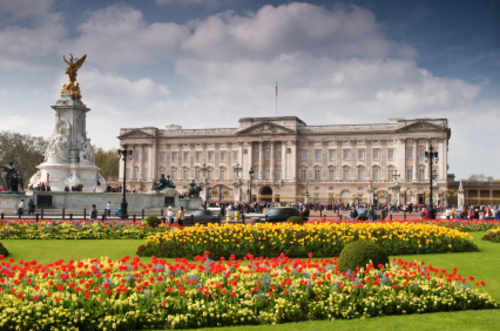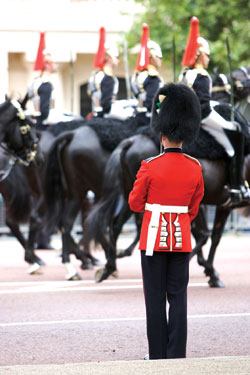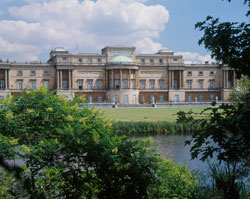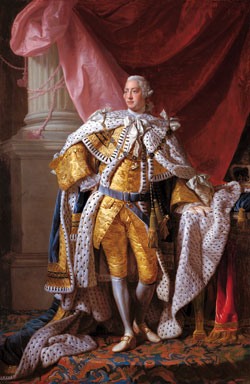Buckingham Palace has been the official London home of the British monarch since 1837 and today is home to HM Queen Elizabeth II and The Duke of Edinburgh
Step inside Buckingham Palace and discover the historic treasures within these world-famous walls.
|
|
Buckingham PalaceBuckingham Palace, London SW1A 1AA
020 7766 7300 Buckingham Palace |
“I delight in Buckingham Palace” Queen Victoria is said to have uttered when she moved in, in 1837. It’s hardly surprising when you consider the lavish State Rooms: a riot of gilt and colour. However, the palace, which became the official royal residence on her arrival (instead of St James’s Palace), had considerably altered its appearance from what the first Duke of Buckingham commissioned in 1703.

The Duke’s new townhouse, Buckingham House, was a more modest, three-floored building consisting of a central block with two small wings. It caught the eye of George III and, in 1761, was bought for £28,000 as a private retreat for the royal family – in particular, for his Queen, Charlotte. It became known as ‘the Queen’s House’ and 14 of their 15 children were born there.
But perhaps today’s palace owes most to George IV, who in 1825 enlisted the help of his architect John Nash to enlarge and modernise the building – this dynamic duo had previously created the fantasy palace, the Royal Pavilion at Brighton.
 |
| Colourful pageantry |
A thousand workmen were hired to cover the exterior with honey-coloured stone from Bath and the two wings were rebuilt to the same height as the main block. Marble Arch was designed to be placed in the centre of the forecourt as a grand entrance to the palace. However, with grand plans came great cost and after the death of the king, and the palace still unfinished, the Prime Minister, the Duke of Wellington was called on to “make a hash of Nash” and remove him from the project.
Despite the new king, William IV, showing no desire to move in – he preferred Clarence House – architect Edward Blore was employed to complete Nash’s design but in a ‘plainer’ style.
Although it is Nash that normally gets the glory for Buckingham Palace, it was in fact Blore who designed and created its most distinctive feature, the East façade, when he returned in 1847 at the request of Queen Victoria. The queen might have been struck with the palace when she first moved in but in reality it was far from ideal. She and husband Prince Albert soon found it too small for their growing “little family”. As a result, Marble Arch was moved to the top of Park Lane and the new east wing was built enclosing the central quadrangle. Today, this is very much the ‘public’ face of the palace and bears the balcony from which the Royal Family greets the crowds on important occasions.
Of the 775 rooms within Buckingham Palace, only 19 can be seen by the public. These are the State Rooms – open annually when the Queen goes away for the summer – and they form the heart of the working palace, used regularly by the Queen for official and state entertaining as well as the 25 investitures that take place each year.
 |
| The view of the palace from the gardens |
Few could fail to be impressed as they climb the Grand Staircase with its intricate gilt bronze banistery, under the watchful gaze of Queen Victoria’s symbolically-placed family portraits, and into the Green Drawing Room. The green silk was woven especially for this room and candelabras and Sèvres porcelain sit in front of huge mirrors to amplify the light. The Throne Room next door is where Nash’s influence is immediately apparent. The huge proscenium arch creates a theatrical feel and many of the more elaborate pieces in the room were ‘recycled’ from George VI’s bachelor pad, Carlton House. The Coronation Chairs take centre stage flanked by the ornate council chairs, and, if you look up, a white frieze depicting moments from British medieval history circles the room.
Initially, Queen Victoria used this space for balls but, after declaring that there was no room for ladies skirts, she had a ballroom built. At the time of its construction it was the largest room in London and was opened in 1856 with a ball to celebrate the end of the Crimean War. The Ballroom is still the largest room in Buckingham Palace and today is used as the regular venue for investitures. Many famous faces have knelt before Her Majesty to receive their knighthoods, however perhaps the one that caused most confusion was Sir Maurice Micklewhite. “Who’s he?” people asked, before being told his alter ego – Michael Caine.
The Ballroom is also used to host the State Banquet, attended this year by President Obama. Up to 160 can be seated, strictly nine inches apart, with the Queen’s guest of honour on her direct right. What most guests won’t see is the system of ‘traffic’ lights behind the scenes ensuring that the food is served in an orderly, prompt fashion and – of course – piping hot.
For other occasions, there’s the State Dining Room. Rumour has it that the Queen prefers smaller, round tables so it’s easier to talk but mostly this room arranged with one long table. Take a closer look at the silver-gilt centrepiece made by Prince Albert for Victoria and you’ll see representations of the couple’s favourite greyhounds – one of which was so popular that he was painted by renowned British artist, Edwin Landseer.
Adorning the wall is a portrait of George IV dressed up like a “Christmas tree” in every piece of royal finery, his hand dangling nonchalantly on a table. This circular Table of the Grand Commanders can be found next door in the Blue Drawing Room (until 11 October it can be seen in The Queen’s Gallery as part of the French Porcelain for English Palaces exhibition) and was highly coveted by George IV. Commissioned by Napoleon in 1806, the Sèvres porcelain table top features portraits of Alexander the Great and other great commanders including Julius Caesar and Hannibal. Perfect for a man of ambition.This room, with its highly ornate ceiling, was the setting for Cecil Beaton’s portrait of the late Queen Mother and where Elton John played the piano for the Queen’s Jubilee. Perhaps if the acoustics had been as good he would have played next door in The Music Room. However, this is most famous as the scene of royal christenings, including those of the Prince of Wales, The Princess Royal, The Duke of York and Prince William – all christened by the Archbishop of Canterbury.
From here you are fast approaching the Queen’s private apartments, in fact in the White Drawing Room you are closer than ever. I won’t ruin the surprise but see if you can spot the hidden door from which members of the Royal Family emerge. Also in here you’ll see the roll-top desk by Jean-Henri Riesener, the Rolls Royce of furniture, and the perfect place for keeping state secrets as it can only be opened with a unique sequence.
 |
| State portrait of George III by Allan Ramsay |
This is just one of the many treasures to be found within the palace. For more, don’t miss the 47-metre-long Picture Gallery lined with work by Holbein, Rembrandt, Rubens and Canaletto.
Directly below is the Marble Hall which leads through to the Bow Room – scene of the late Queen Mother’s 100th birthday lunch – and out onto the terrace. Lucky garden party guests congregate here, gazing out over the park-like garden – originally landscaped by Capability Brown – towards the lake. Truly an oasis in the heart of London.
Back out on the Mall a memorial statue to Queen Victoria now stands. It seems quite apt that the monarch who had such an impact on this palace should forever be gazing out from her “delight”.
- Tel: (020) 7766 7322 or visit:





 © 2024
© 2024